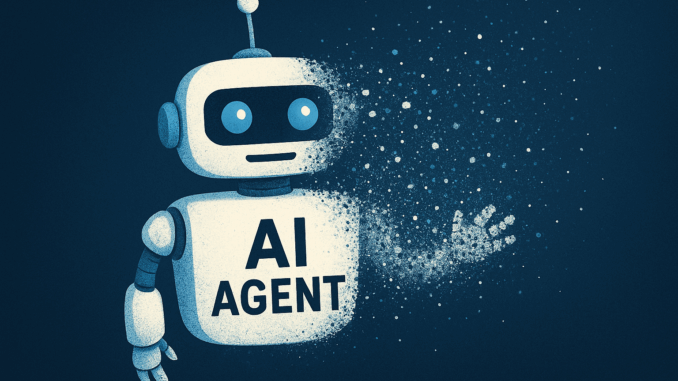
TL;DR
Just as web services quietly evolved into service-oriented architecture once reality caught up to ambition, the loud promises of autonomous AI agents have given way to bounded, practical applications solving real customer problems. This is not the end; it is maturity.
Introduction: The AI agent vanishing trick
AI agent solutions have dominated technology headlines for several years. In early 2024, AI agent demos filled the Google Cloud Summit London programme. Demos featured AI agents booking holidays, managing finances, and coordinating logistics. Ten months later at the same venue, AI agent sessions vanished. Instead, the conversation shifted to practical, domain-specific uses of AI. This shift reveals a vital truth: the AI agent has not failed, it has matured.
In the first quarter of 2024, the AI agent dominated technology events. Vendors showcased autonomous AI agent systems promising to automate wide swathes of business operations. By the start of 2025, the AI agent was largely absent from the main stage. Most enterprise IT leaders have shifted to practical, user-facing AI agent deployments with well-defined roles.
This change signals not failure, but the arrival of maturity for the AI agent. Engineers are building systems that serve real business needs, and vendors have adjusted their messaging to match what works in production.
Why AI agent hype outpaced reality
The pattern is familiar to experienced technology professionals. Microservices once promised effortless scale and velocity, but hidden complexity forced teams to re-focus on developer experience and system reliability (The New Stack, 2022). The AI agent wave followed a similar course.
The reality gap stems from three root challenges:
- Trust boundaries: Most Chief Information Security Officers will not allow an AI agent to access wide portions of the corporate stack. Security and compliance require tight controls and robust audit trails.
- Error propagation: AI agent solutions that rely on chains of decisions can suffer from compounding errors. Even a 1% mistake rate in each step can multiply rapidly, producing unreliable outcomes (Harvard Business Review, 2023).
- Data quality: Many AI agent systems require structured, accessible data to function. Enterprise data is often fragmented or inconsistent, which creates serious implementation risks (Stanford Encyclopedia of Philosophy, 2021).
AI agent solutions that actually deliver
Despite the initial hype, the most valuable AI agent use cases are practical, focused, and bounded by clear constraints.
- Starling Bank’s AI agent for spending intelligence: Customers use natural language to query their transactions and spending patterns (Starling Bank Blog, 2024).
- Morrisons’ AI agent for in-store navigation: Shoppers get conversational, location-specific help finding products (Retail Gazette, 2024).
- Loveholidays’ AI agent, Sandy: This AI agent handles more than half of multilingual support requests and escalates only when necessary (Travel Weekly, 2024).
The common thread: each AI agent solves a specific problem, with transparent scope, human fallback, and measured impact.
Human experience: AI agent success and disappointment
Some readers will recall Microsoft Clippy or the first generation of chatbots. These early “intelligent agent” systems often disappointed users, with limited flexibility and poor real-world comprehension (TechRadar, 2022). Modern AI agent systems succeed when they are bounded and solve genuine user problems.
Starling Bank’s team built their AI agent to provide clarity, not to replace human advice. Morrisons’ engineering group focused on retail utility, not grand visions of digital butlers. At Loveholidays, their AI agent, Sandy, provides efficiency and satisfaction because it respects its limits.
What enterprise leaders should do next
- Review current AI agent deployments: Confirm that each system operates within strict boundaries. Audit permissions, integrations, and data quality.
- Set outcome-based goals: Every AI agent project should have a defined business goal and measurable performance metrics.
- Prioritise trust and fallback: Where possible, design each AI agent system so users can always reach a human if required.
- Measure real-world value: Report user adoption rates, satisfaction, and operational cost savings for each AI agent deployment.
Most importantly, do not abandon AI agent solutions because hype has faded. Instead, focus on practical, high-impact use cases that deliver business value and user satisfaction.
Further Reading
- Agents, Agents Everywhere: Google Cloud Summit – Computing.co.uk, 2024
- Where Are All the AI Agents? – Computing.co.uk, 2025
- Google Customers Turn from Agents Towards CX – Computing.co.uk, 2025
- Service Mesh: A History of Hype and Reality – The New Stack, 2022
- Artificial Intelligence – Stanford Encyclopedia of Philosophy, 2021
- Managing Risks in AI Deployments – Harvard Business Review, 2023
- AI in Banking – Starling Bank Blog, 2024
- Morrisons AI Shopping Assistant – Retail Gazette, 2024
- Loveholidays’ Sandy: AI Agent – Travel Weekly, 2024
- The History of Chatbots – TechRadar, 2022

Leave a Reply